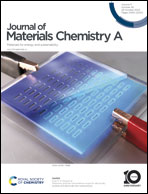Highly sensitive self-powered ammonia gas detection enabled by a rationally designed PANI/commercial cellulosic paper based triboelectric nanogenerator†
Abstract
Triboelectric nanogenerators (TENGs) have been widely used for self-powered gas sensors recently. However, limitations such as low sensitivity especially for trace concentrations of NH3 and narrow detection ranges inevitably pose serious challenges. Herein, a kind of highly sensitive self-powered gas sensor based on a PANI/cellulosic hierarchical structure (PC-TENG) was developed to detect NH3 gas. The hierarchical structure provides excellent gas permeability and huge numbers of gas adsorption sites. Meanwhile, the most effective structure design of the integrated self-powered NH3 sensors (PANI acts as the electrode/tribo-material) was identified by a comparison of different structure designs (PANI plays a single role of the electrode or tribo-material, or double roles of the both). Benefitting from the abundant gas adsorption sites, and the coordinate regulation of the PANI's surface tribo-state and impedance caused by protonation–deprotonation of PANI, the rationally designed PC-TENG exhibits outstanding sensing properties, with a minimum detection limit as low as 100 ppb and a maximum limit of 500 ppm, wherein the maximum output voltage and current of the PC-TENG are 23 V and 0.17 μA, respectively. And the sensitivity of the PC-TENG was up to 45.41% ppm−1 from 0.1 to 1 ppm, and 15.17% ppm−1 from 1 to 50 ppm. In particular, the sensitivity for trace concentrations of NH3 (0.1 to 50 ppm) is the highest value among reported studies. In addition, the mature processing technique of commercial nitro-cellulosic paper and its eco-friendly nature further provide the feasibility of large-scale production and application of environmentally friendly self-powered NH3 sensors.



 Please wait while we load your content...
Please wait while we load your content...